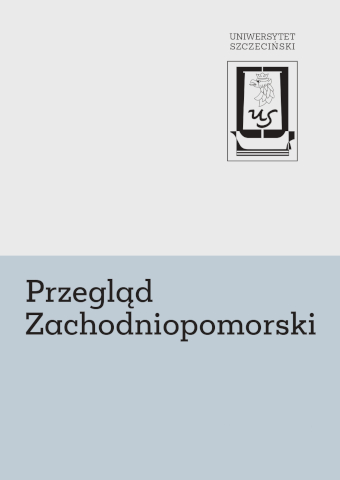







| Authors: |
Wojciech
Skóra

Akademia Pomorska w Słupsku |
| Keywords: | The Soviets Red Army Pomerania town fires Słupsk landsmannschaft |
| Data publikacji całości: | 2021 |
| Page range: | 41 (151-191) |
brak plików graficznych i oświadczenia, konieczność poprawy przypisów, wszystko po recenzjach
| 1. | Archiwalia |
| 2. | Biblioteka Akademii Pomorskiej w Słupsku, spuścizna Polskiego Towarzystwa Historycznego, teczka 61, Stanisław Witek, „Wspomnienia z lat 1939-1945 (Jezierzyce, 1964 r.)”. |
| 3. | Bundesarchiv Koblenz, Ost-Dok 8 Po, nr 40. Bericht über die Räumung des W.B.K. Stolp und der Wehrmeldeämter Stolp Lauenburg, Rummelsburg und Schlawe, 25 IV 1945 r. |
| 4. | Centralne Archiwum Ministerstwa Obrony Federacji Rosyjskiej, zespół 7742, inwentarz 62016, sprawa 11, Dziennik operacji wojskowych 1072 Pułku Piechoty. |
| 5. | Centralne Archiwum Ministerstwa Obrony Federacji Rosyjskiej, zespół 6705, inwentarz 123215, sprawa 11, Dziennik operacji wojskowych 239 Pułku Piechoty. |
| 6. | Prasa |
| 7. | Красная звезда (Krasnaja Zwiezda), 10.03.1945, 58. |
| 8. | Stolper Heimatblatt 2 (1952). |
| 9. | Stolper Heimatblatt 2 (1953) |
| 10. | Stolper Heimatblatt 2 (1953). |
| 11. | Stolper Heimatblatt 3 (1952). |
| 12. | Stolper Heimatblatt 3 (1955) |
| 13. | Stolper Heimatblatt 3 (1955). |
| 14. | Stolper Heimatblatt 4 (1952). |
| 15. | Stolper Heimatblatt 4 (1953). |
| 16. | Stolper Heimatblatt 5 (1952). |
| 17. | Stolper Heimatblatt 6 (1952). |
| 18. | Stolper Heimatblatt 6 (1953). |
| 19. | Stolper Heimatblatt 7 (1952). |
| 20. | Opracowania |
| 21. | Adamkiewicz, Leszek. Dymy nad Gdańskiem. Agonia Prus Zachodnich. Zakrzewo: Replika, 2013. |
| 22. | Adressbuch Stolp 1938. Słupsk, 1938. |
| 23. | Anduła, Kamil. „Bitwa w Pradolinie Redy-Łeby. Działania bojowe sowieckich wojsk pancernych na kierunku Gdyni (6-16 marca 1945 r.)”. Przegląd Historyczno-Wojskowy 4 (2020): 42-83. |
| 24. | Anduła, Kamil. 1 Warszawska Brygada Pancerna im. Bohaterów Westerplatte. Warszawa: Tetragon, 2015. |
| 25. | Artur Sikorski, Krzysztof Skrzypiec, Tomasz Urbaniak. „Rys historyczny”. W: Słupsk w dokumencie archiwalnym, red. Joanna Chojecka, Artur Sikorski, Krzysztof Skrzypiec, Tomasz Urbaniak, 17-18. Koszalin: Archiwum Państwowe w Koszalinie, 2018. |
| 26. | Die Vertreibung der deutschen Bevölkerung aus den Gebieten östlich der Oder-Neiße. Augsburg: Weltbild Verlag, 1993, Bd. 1. |
| 27. | Dzieje Słupska, Słupsk 1986. |
| 28. | Friedrich, Jörg. Pożoga. Bombardowanie Niemiec w latach 1940-1945. Warszawa: MDI Books, 2011. |
| 29. | Gierszewski, Stanisław red., Historia Słupska. Poznań: Wydawnictwo Poznańskie, 1981. |
| 30. | Grajczak, Dagmara. „Die Russen kommen... Zajęcie Słupska przez Armię Czerwoną w marcu 1945 r. w relacjach mieszkańców miasta”. W: Słupsk i ziemia słupska od średniowiecza do współczesności, red. Wojciech Skóra, Agnieszka Teterycz-Puzio. Słupsk: Wydawnictwo Naukowe Akademii Pomorskiej, 2021, (w druku). |
| 31. | Groll, Erhard. Paninka. Paninka oder die Wahlverwandtschaft. Leverkusen: Kremer-Verlag, 1997. |
| 32. | Kabatek, Mateusz. Lotnictwo w Słupsku 1912-1945. Słupsk: Stratus, 2016. |
| 33. | Kopelev, Lew. No Jail for Thought. Londyn 1977. |
| 34. | Kopelew, Lew. Aufbewahren für alle Zeit! Aus Ostpreußen in russische Straflager. Ein Sowjetmajor im Widerstand. Hamburg: Verlag Hoffmann und Campe, 1976. |
| 35. | Kopf, Stanisław. Wyrok na miasto. Warszawskie Termopile 1944-1945. Warszawa: Askon, 2001. |
| 36. | Leszczyński, Adam. Ludowa historia Polski. Historia wyzysku i oporu. Mitologia panowania. Warszawa: Grupa Wydawnicza Foksal, 2020. |
| 37. | Lindenblatt, Helmut. Pommern 1945. Eines der letzten Kapitel in der Geschichte vom Untergang des Dritten Reiches. Leer: Verlag Gerhard Rautenberg, 1993. |
| 38. | Łobacz, Witold. „Rozwój urbanistyczny Słupska (1945-1966)”. W: Z najnowszych dziejów Słupska i ziemi słupskiej (1945-1965), red. Kazimierz Podoski, 159-173, Poznań-Słupsk: Wydawnictwo Poznańskie, 1969. |
| 39. | Małkowski, Kazimierz. „Zniszczenia Gdyni w wyniku bombardowań, ostrzału artyleryjskiego i walk od pierwszego do ostatniego dnia II wojny światowej”, Zeszyty Gdyńskie 5 (2010): 77-84. |
| 40. | Merridale, Catherine. Wojna Iwana. Armia Czerwona 1939-1945, Poznań: Rebis, 2007. |
| 41. | Murawski, Erich. Bój o Pomorze. Ostatnie walki obronne na wschodzie. Oświęcim: Napoleon V, 2017. |
| 42. | Pagel, Karl-Heinz. Stolp in Pommern - eine ostdeutsche Stadt. Ein Buch über unsere pommersche Heimat. Lübeck, 1977. |
| 43. | Podoski, Kazimierz red. Z najnowszych dziejów Słupska i ziemi słupskiej 1945-1965. Poznań-Słupsk: Wydawnictwo Poznańskie, 1969. |
| 44. | Romanow, Zenon. „Zajęcie Słupska przez Armię Czerwoną w 1945 roku”. W: Życie dawnych Pomorzan I, red. Wojciech Łysiak, 237-246. Bytów-Poznań: Wydawnictwo Eco, 2001. |
| 45. | Sakson, Andrzej. „Wielki symbol polskiej klęski, czyli uwagi o demitologizacji Ziem Odzyskanych i marginalizacji Ziem Zachodnich i Północnych”. W: „Ziemie Odzyskane”. W poszukiwaniu nowych narracji, red. Emilia Kledzik, Maciej Michalski, Małgorzata Praczyk, 145-158. Poznań: Uniwersytet Adama Mickiewicza, 2018. |
| 46. | Sobczak, Janusz. Hitlerowskie przesiedlenia ludności niemieckiej w dobie II wojny światowej. Poznań: Instytut Zachodni, 1966. |
| 47. | Sołżenicyn, Aleksander. Pruskie noce. Warszawa: Ośrodek Karta, 2018. |
| 48. | Szalewska, Elżbieta. Słupsk. Podstawy kształtowania ładu przestrzennego. Słupsk: Wydawnictwo Naukowe Akademii Pomorskiej, 2002. |
| 49. | Tajemnice walizki generała Sierowa. Dzienniki pierwszego szefa KGB 1939-1963. Konstancin: Rea-Sj, 2019. |
| 50. | Wolski, Janusz. „Rozstrzelanie 22 więźniów w Słupsku”. W: Zbrodnie hitlerowskie na ziemi koszalińskiej w latach 1933-1945, red. Andrzej Czechowicz, 124-132. Koszalin, 1968. |
| 51. | Zander, Klaus. Kinderland ist abgebrannt. Erlebnisse eines kleinen pommerschen Jungen in den Jahren 1940-1946, bmw: Berlin epubli GmbH, 2011. |
| 52. | Netografia |
| 53. | „72 rocznica powrotu Słupska do Polski”, http://www.koszalin.ap.gov.pl/72-rocznica-powrotu-slupska-do-polski/, dostęp 25 I 2021). |